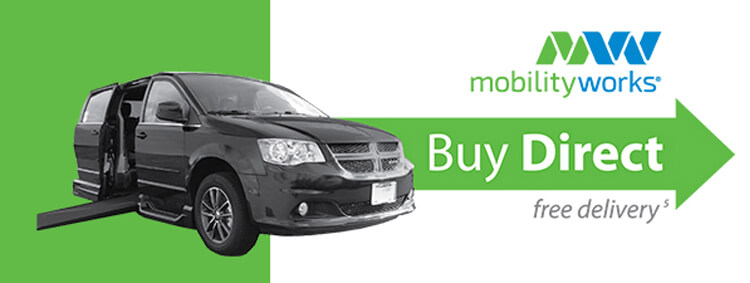You may have heard the terms “wheelchair lifts” or “scooter lifts.” In fact, you may even have heard these items referred to as “wheelchair hoists” or “stowage lifts.” However, did you know that these items can also be called “freedom-enhancing products” because of their ease and convenience? To begin, let’s take a look at the two types of wheelchair lifts: occupied wheelchair lifts and unoccupied wheelchair lifts.
Occupied Wheelchair Lifts

Full-Size Vehicle with
Occupied Wheelchair Lift
Occupied wheelchair lifts are designed to lift people while they are seated in their wheelchair or scooter. We will be covering these types of lifts in more detail in a future issue. In the meantime, you can find more information on occupied wheelchair lifts on our website. You can also feel free to contact one of our experienced Mobility Consultants for more information.
Unoccupied Wheelchair Lifts

Bruno Joey VSL-4000 Lift

Bruno Curbsider Lift
Unoccupied wheelchair lifts are also referred to as “scooter lifts” or “stowage lifts.” Essentially, unoccupied wheelchair lifts are designed to lift and stow a wheelchair or scooter only.
Is an Unoccupied Wheelchair Lift Right for You?
Many people need to use a wheelchair or scooter to get around, although they still have the ability to transfer from their mobility device into a vehicle seat—either on their own or with assistance from a companion. For these people, a wheelchair or scooter lift may be just the option they need to give them greater freedom to travel with their personal mobility device.
What Lifts Are Available?
| Internal Platform | Internal “Crane” Style | External Hitch Mount | |
|---|---|---|---|
| Summary | • Best lift available • Easy to use • High lifting capacity • Secure storage |
• Strong • Storable lifts keep scooters inside the vehicle. • Lift swings to the side when not in use. |
• Inexpensive • Does not take up any interior vehicle space. • Best for warmer, drier climates! |
| Higher Lifting Capacity (251-450 pounds) | • Joey VSL 4000 | • Curbsider VSL 6900 • Curbsider VSL-6000 • Big Lifter VSL 570 • Scooter Lift VSL-400 |
• Outsider Meridian ASL-250 • Out Rider PUL-1100 • Pow’r Topper PCL-1900 |
| Medium Lifting Capacity (151-250 pounds) | N/A | • Scooter Lift ASL 400 • Scooter Lift II VSL 900 • Space Saver ASL-325 • Offset Fold-Away ASL-450 • Space-Saver ASL 350 |
N/A |
| Lower Lifting Capacity (Up to 150 pounds) | N/A | • Cab-Sider PUL-1700 • Wheelchair Lifter AWL-150 |
• Back Saver AWL 1600 • Out-Sider Micro Scooter Lift ASL 225 |
| Chassis Options | Minivans only: • Dodge Grand Caravan • Chrysler Town & Country • Honda Odyssey • Toyota Sienna |
• Depends on style and capacity. • Minivans and SUVs are needed for the largest wheelchair/scooter options. • Smaller chairs can work with many medium–large sedans. |
• Can fit any chassis that can support the prescribed trailer hitch specifications. |

Bruno Outrider PUL-1100 Lift

Bruno Cab-Sider PUL-1700 Lift
Choosing the Right Wheelchair/Scooter Lift — A Three-Step Process
Once you determine that a wheelchair/scooter lift may meet your needs, how do you choose the right one? As with many other mobility solutions, the solution is like putting together a puzzle. We have found that if you go through the process correctly, you are most likely to succeed in the end.
Step 1: Assess Your Needs
The most important items to consider when you are assessing your situation/needs are the following:
- What are the make and model of the wheelchair or scooter you will use? The size, weight, and dimensions of the wheelchair/scooter will have a huge influence on your options.
- What are the make, model, and year of the vehicle you are currently driving? Would you like to continue to drive it?
- How fit/strong/healthy are you or the person who will help you use the wheelchair/scooter lift? Your answer to this question will influence the type of lift that will be easiest to operate and whether or not you will be able to use a less expensive lift that has fewer power features.
- How many total passengers will you need to transport in addition to the wheelchair user and the mobility device? What other items will you need to transport in the vehicle?
- What is your budget? As with all things, there is a range of prices, and both new and used models of wheelchair/scooter lifts are available.
Step 2: Develop Options
Once the information above is gathered, we will work with our manufacturers to assemble a list of possible combinations of vehicles and wheelchair lift models that will work for you. If you and your wheelchair/scooter are not particularly large nor do you need to transport a lot of people in your vehicle, then you may have many options to choose from. Conversely, as people get larger—both in size and number—and the size of mobility devices become larger, then options will narrow considerably.
Step 3: Evaluate the Options
Each option will have its pros and cons, and making the right choice is all about trade-offs. Will you need to purchase a new vehicle? Will certain options eliminate additional seating? Are the best options beyond your means? An experienced Mobility Consultant will help you understand each combination as well as the benefits and limitations they present.
4 Helpful Reminders!
- Don’t buy a car or wheelchair lift without talking with us first! Too often, people buy a new vehicle expecting to equip it with a wheelchair lift, only to find out later that it won’t work. Other times, people buy a used wheelchair lift on the Internet or from a friend, again only to find out that it won’t work with their car or wheelchair. Take your time, and hold on to your money until you are sure you have the right solution—it will save you in the long run!
- Don’t buy less than you need. While wheelchair and scooter lifts make transporting your device easier, they may be difficult for elderly people or individuals who have trouble bending or standing. If you have a hard time using a more manual lift, you will not use it as much, and your mobility/independence will be limited. Also, you could be risking injury if you have a hard time handling a more manual wheelchair lift. Since you will be making a financial investment in a wheelchair lift you’ll hope to have for a long time, make sure you get the best solution for you.
- Avoid exterior lifts. We recommend that you avoid investing in an exterior wheelchair lift, if possible—and especially in northern climates. Exterior lifts are the least expensive and take up no space inside the vehicle. However, your mobility device is exposed to the elements even if it is covered. In addition, having a 3- or 4-foot lift hanging off the back of your car is a hazard, and many people damage the lift and mobility device (as well as other people’s cars, mailboxes, etc.) while backing up. You will find that buying a more expensive lift is better than paying for repairs!
- Plan for the future. If the condition of the wheelchair user or companion is likely to result in additional mobility loss or loss of strength, be sure to take this into consideration. You may be better off buying a better lift or even going straight to a wheelchair van rather than taking an interim step. Your Mobility Consultant can help you to make this determination.
Frequently Asked Questions
Can I move my wheelchair lift to a new vehicle later?
If you stay with the same style of vehicle, you will most likely be able to transfer your wheelchair lift. You may need to acquire a new mounting kit in order to transfer. Again, ask us first! If you are changing vehicle types then you may not be able to use the same lift in your new car. With a quick phone call, we can answer this question for you.
What if I get a new wheelchair or scooter? Do I have to get a new lift?
You will most likely not need a new wheelchair lift, but you probably will need some new mounting hardware to accommodate the new wheelchair or scooter. Again, it is better to be safe than sorry, so give us a call with the new make and model of your wheelchair/scooter, and we will give you the correct answer.
What if I want to sell my car? Can the wheelchair lift be removed? Will it leave marks?
In most cases, the wheelchair lift can be removed, and with some minor repairs, only minimal damage or wear will be visible.
As with any major mobility purchase, we encourage you to do your research and to consult with an experienced Mobility Consultant. The team at VCI Mobility is ready and willing to help you in any way that we can…contact us today.



